
A nice evening at Eisenturm
On Friday, October 11th, I was thrilled to open my latest exhibition, Ich wunder mich, at Kunstverein Eisenturm in Mainz. The evening began with introductions by Petra Schippers, president of the Kunstverein, and art historian Miriam Maslowski, with whom I had the pleasure of a public conversation discussing the ideas behind the exhibited works.
Ich wunder mich delves into my ongoing research on human perception and cognition, exploring the diverse ways we interpret and interact with the world around us. I am particularly drawn to the often-overlooked details that surround us daily, and the subtle beauty or poetry within elements that many might consider unattractive or mundane. This exhibition transforms these themes into poetic, narrative-driven installations that invite reflection—a quiet celebration of cognitive diversity and the richness it brings to our experience of the world.
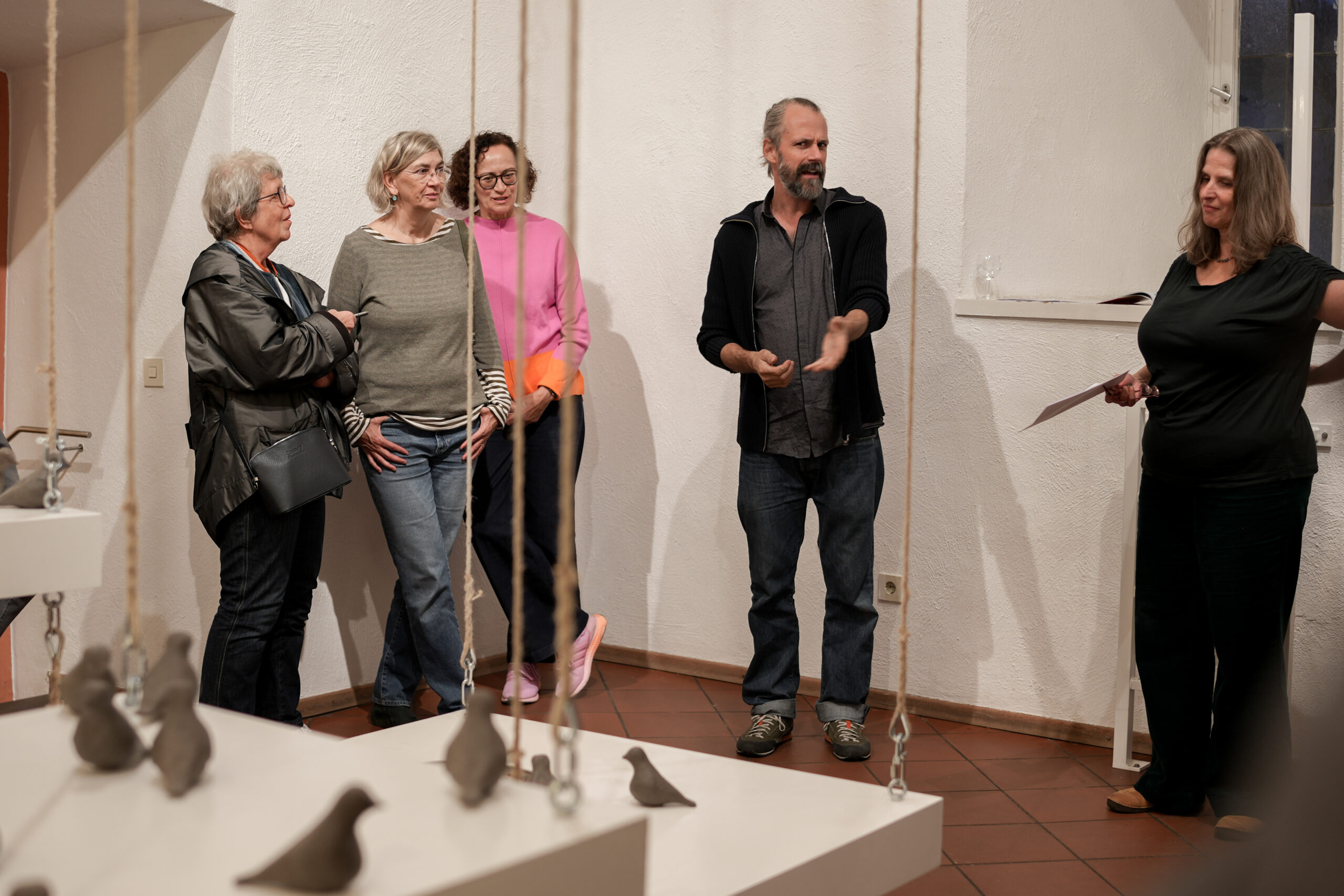

The first work viewers encounter is a room-sized installation, called Urban sanctuary, featuring three white platforms, each suspended at different heights from ropes attached to the ceiling. The largest platform contains a sewer lid, from which a bright, white light radiates. Scattered across the platforms are numerous ceramic birds: two are perched near the illuminated sewer lid, while the others maintain a noticeable distance, choosing the remaining platforms instead.
This work finds its origin in a seemingly insignificant moment I observed over a year ago. Leaving a park on a warm summer day, I passed the back entrance of a shopping mall where delivery trucks are unloaded. Amid the litter and on a rough concrete slab, I noticed two birds lingering near a sewer lid. This simple scene, in its unexpected beauty, inspired a reflection on the quiet, unnoticed spaces in urban life.
In this new setting, the work takes on a surreal quality, crafting a poetic narrative that deepens the beauty and mystery of the frozen moment. Rather than solving the enigma or imposing ideas, it invites the viewer to linger in the unanswered.


As you enter the second room, you encounter Still Life with Bird, positioned directly opposite the entrance. The installation consists of five wooden poles arranged in a row, evoking the quiet presence of a fence. Perched on one of the poles is a single ceramic bird, coated in concrete. This sculptural piece emanates a sense of calm and tranquillity, a stark contrast to the polarising intensity and activism often found in our surroundings and within today’s art world.
Still Life with Bird is purposefully non-political, even anti-political. It resists carrying any overt message, inviting viewers to experience it simply for what it is—a quiet scene, untouched by commentary, a still life with a bird.



In the opposite corner of the room sits a second piece called All together now: 101 ceramic birds densely packed into a single square meter. This work evokes the bustling atmosphere of a city square, where flocks of birds gather in search of food. It feels as though a slice of urban life has been cut out and placed here in the gallery.
The busy, chaotic scene within the square contrasts sharply with the room’s quiet ambiance, while the strict geometry of the installation resonates with the gallery’s architectural elements—the tiled floor, square windows, and the linear design of the radiators. This interplay of forms and energies creates a compelling visual tension within the space.
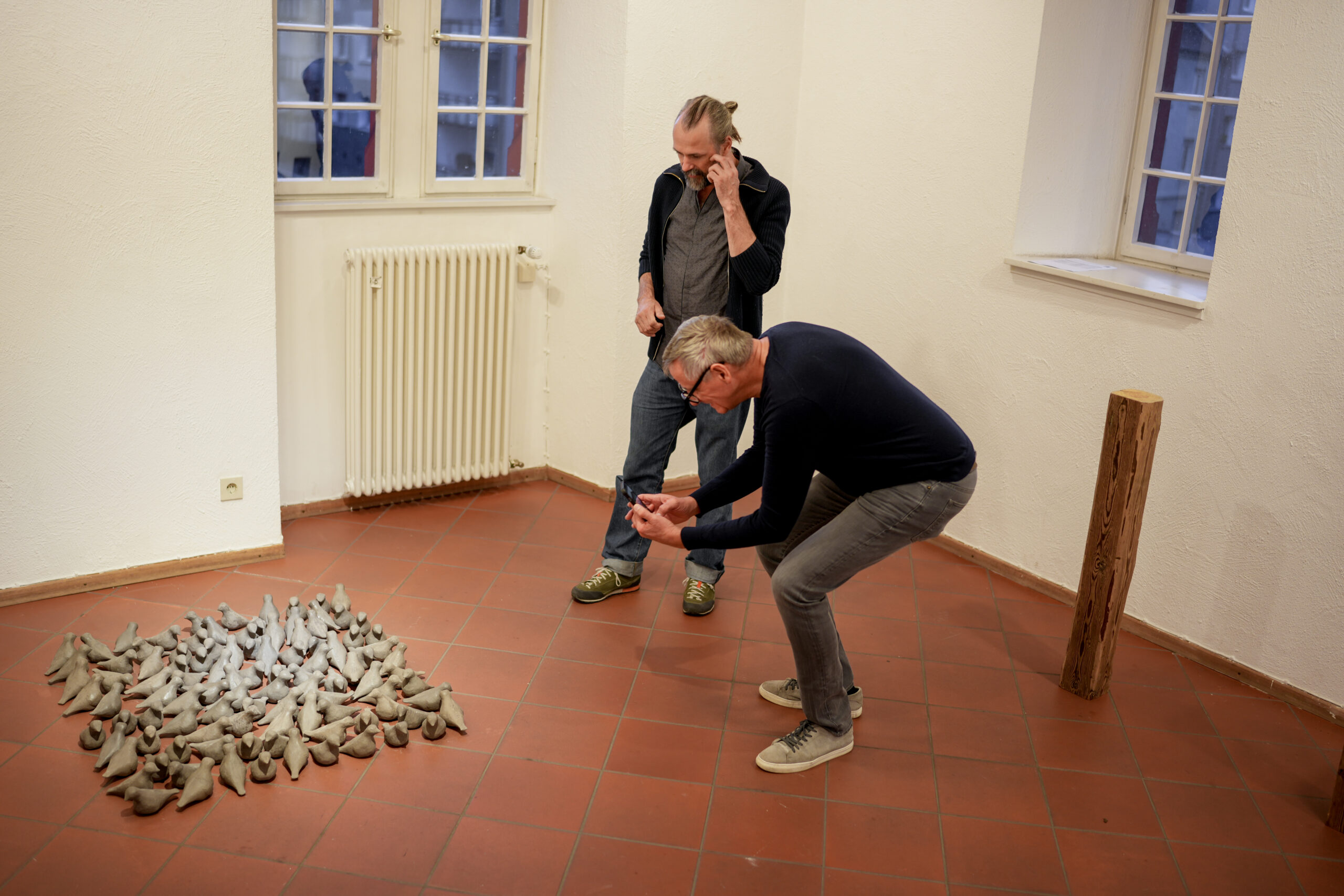
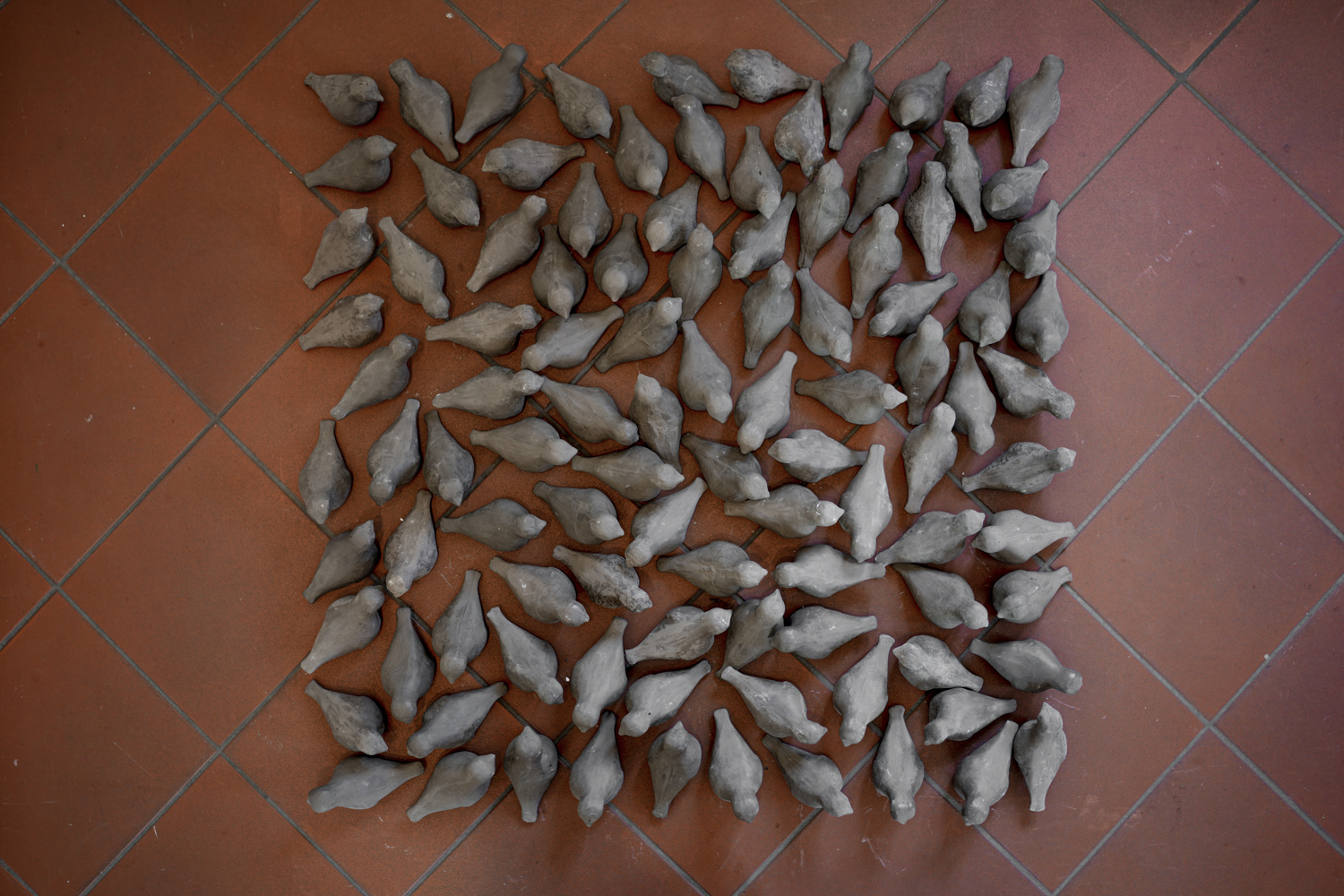

During the installation, the third room at Kunstverein Eisenturm unexpectedly took on a theme reminiscent of If Paradise Is Half As Nice—a project I’ve contributed to over the past 11 years. The works in this room were all created during the last three editions of this collaborative initiative.
Umweltfarben (4 landwerkzeuge), he first piece, positioned on the left wall as you enter, features four agricultural tools hanging from nails as they might in a traditional shed. On closer inspection, each tool reveals a unique, natural monochrome, achieved through coatings of shredded leaves or grass. This work subtly gestures toward rural life, where nature and culture seamlessly blend, and aims to evoke a poetic view of life in the countryside.
Without imposing a particular viewpoint, this piece invites viewers to contemplate life in rural settings. The tools, with their vintage feel, evoke a sense of nostalgia, hinting at a past era without asserting whether it was better or worse—leaving that interpretation open to the viewer.
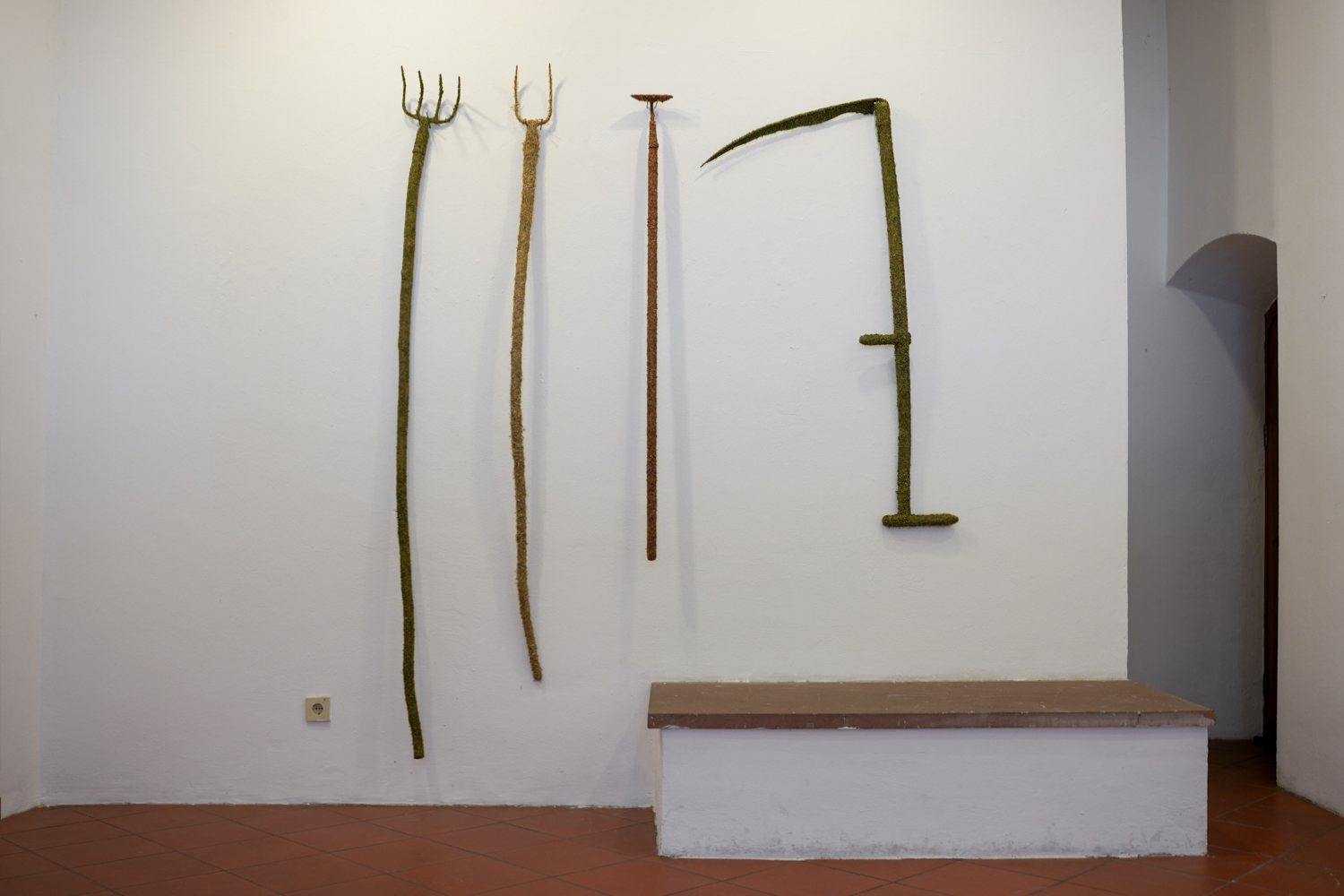
Measures for a Long Life was created during If Paradise Is Half As Nice #13, held in northern Norway as part of the Salangen Biennale. For five weeks, I lived and worked in an abandoned factory building where, by law, the festival organizers were required to install smoke alarms and fire extinguishers throughout the crumbling concrete structure—a space with few windows left intact.
Intrigued by the rigidity of these regulations in such a desolate space, I collected three old fire extinguishers of different models and encased them in concrete, merging them with the stark remnants of the former factories. This work invites multiple interpretations: preserved in concrete, the extinguishers are protected yet rendered functionally obsolete. They evoke a connection to the building’s industrial past, when these factories were vibrant and active. At the same time, the piece hints at our tendency to over-regulate and minimize risk, stripping away elements of adventure and spontaneity from our lives.
In this exhibition, the work has been detached from its original surroundings, thus adding a new chapter in its story.

The third work in this room features a white plinth surrounded by white plaster casts of dented, used spray cans, scattered as if left behind after a graffiti session. Like Measures for a Long Life, this piece displays objects that appear to have absorbed the characteristics of their environment—in this case, taking on the pristine whiteness and order of the gallery space.
The title of this work holds particular importance, offering two layers of interpretation. On one hand, it suggests an invitation to enter the world of street art, a sphere quite distant from my usual practice. Alternatively, it speaks to self-doubt—questioning whether I could truly belong in that culture or if my work would ever “fit in.”
In many ways, this piece subtly questions the “white cube” gallery tradition, reflecting on my position within the art world and exploring the contrasts between the raw, expressive nature of street art and the controlled space of the gallery.

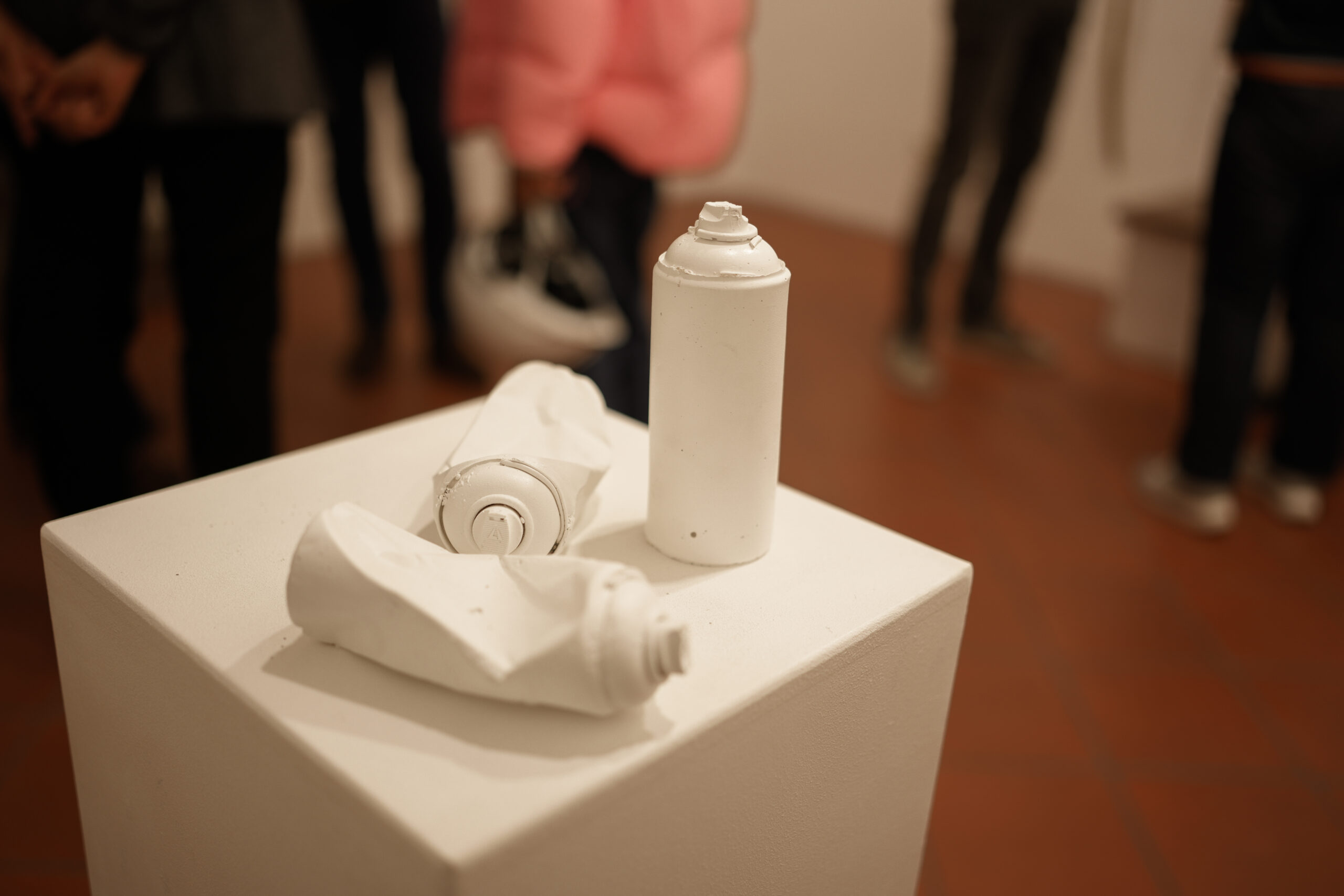

Photo’s: Maryna Semenkova, Ties Ten Bosch
Curator: Barbara Schwarz
Thanks to Petra Schippers, Miriam Maslowski, Kunstverein Eisenturm, Maryna Semenkova, Ronny Lischinski, Ceramic Kingdom and all participants of If Paradise Is Half As Nice.
All works and images © Ties Ten Bosch